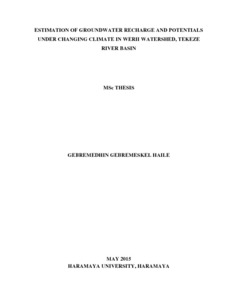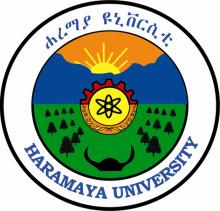Resource information
This study was conducted in Werii watershed (1797 km2) of Tekeze river basin, through integrative use of hydrological and climate models with the objective of estimating the impact of climate change on groundwater recharge and groundwater potentials. Statistical downscaling model (SDSM) was used to downscale precipitation and temperature outputs from REMO (REgional climate MOdel) which in turn was used as input to the WetSpa model to simulate future water balance changes based on A1B and B1 SRES emission scenarios. Abyiadi, Adwa, Hawzen and Adigrat meteorological stations was selected based on proximity to the watershed and data availability. Under A1B scenario, precipitation is likely to increase in each station by 11%, 34%, 31% and 20% at Abyiadi, Adwa, Hawzen and Adigrat stations respectively by 2050. Precipitation will also increase under B1 scenario with consistent rate as that of A1B. Change in maximum temperature is investigated higher at Hawzen for A1B (0.16°c) and B1 (0.2°c) and smaller at Adigart (0.05°c for A1B and 0.02°c for B1). Maximum temperature is expected to be in the range of -0.01°c to 0.2°c. Similarly, minimum temperature will change increasingly and positively with maximum change observed at Hawzen station for A1B (0.34°c) and B1 (0.29°c) and smaller change at Adigrat (0.07°c for A1B and 0.09°c for B1). Future likely climate change projections in precipitation and temperature is positive and will show increasing trend in the period from 2015 to 2050. A fully distributed hydrological model, WetSpa is used to simulate the reference period and future (2015-2050) water balances. At the watershed level, precipitation, recharge and actual evapotranspiration will show 13%, 2-5% and 15-18% increment respectively for both scenarios. Moreover, the baseflow will also increase by 14% and 8% for A1B and B1 scenarios respectively. The surface runoff will show decrement within the range of 22-24%. A spatially distributed water balance model, WetSpass, was also used to estimate long term average seasonal groundwater recharge. The average annual long term groundwater recharge is estimated as 30.06 mm of which 19.51 mm occurs during wet and 9.55 mm occurs during dry seasons. About 77% of the annual rainfall is received in the rainy season, however, only 65% of the total recharge occurs in the rainy season. The annual average precipitation (717 mm) is distributed as 90.7% (650.16 mm) evapotranspiration, 6% (44.06mm) runoff, and 4.2% (30.06mm) recharge. WetSpa and WetSpass were compared and their simulations were found consistent. Increased exploitation of these groundwater resources which is equivalent to the water resources increment is recommended. However, optimal allocation of the groundwater resources is useful to sustain the water resources in the watershed.



